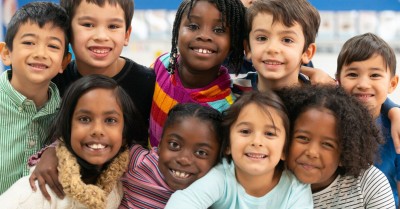Learning about similarities and differences in people can be thought of as two sides of the same coin – that of appreciating what makes people different while respecting their fundamental humanity. The following article provides strategies on how to teach children about similarities and differences in people.
Children are astonishingly adept at spotting differences in the outside world. By having a conversation with them about what they see, adults can help children as they attempt to make sense of differences.
- Children may ask why one leaf on a tree is brown and the rest are green. They also might ask about differences in people around them, such as skin colour, daily practices and routines, language, and physical abilities. When they say, “That woman talks funny,” they are really just letting you know that they notice something different. Adults can help children make sense of the differences they notice.
- When people support a youngster's innate propensity to spot distinctions, they convey to the child that making observations about the world is acceptable. This refers to kids' ability to utilise scientific reasoning and the inquiry cycle in the future.
- More than what they say, adults' behaviours have an impact on children's attitudes about diversity. For instance, search for children's books that include kids of various genders, ethnicities, and abilities. This shows kids that all sexes, ethnicities, and abilities are important.
Strategies To Implement
Model It Right
Embodying respect for diversity in your own words and actions is perhaps the most immediately effective way to teach it to your learners. Talking about other cultures in a respectful way or extending a warm greeting to families of your multicultural children will go a long way in modelling respect for diversity in your room. Better still, set aside some time to learn about a student’s cultural background, hobbies, and learning styles, and see if they need one-to-one meetings to discuss academic progress or any other classroom issues.
All such steps will make students of different backgrounds and abilities not feel included in class but set the bar for other students as well.
Create an inclusive classroom.
Counter Stereotypes
Stereotypes are based on differences that are unrealistically exaggerated and sweepingly applied. In order to drive home the essential similarities in people, try to break stereotypes around family, aptitude and work. You can invite speakers or show videos that show men in non-traditional gender roles, people of different races in leadership positions or individuals with different abilities participating in day-to-day life.
Encourage Group Work
The more children play and work together, the easier it will be to teach them about what unites us like the need for mutual respect, fair play, cooperation, understanding and empathy. Design activities that are more interactive and require collaboration. Plan group assignments so that even as children encounter different perspectives, they know the importance of working together to solve a problem.
How to Incorporate Diversity Within The Learning Environment
- Broaden topics or storytelling sessions to include various cultures, continents, mythologies as well as abilities.
- Make it a point to use other communities, countries and people as references and analogies when planning assignments or projects. These will not only make diversity acceptable to the class as a whole by help students with diverse backgrounds to personally connect with the learning process.
- Host Culture Days or celebrate festivals of other cultures during which children can give presentations about their family traditions to increase familiarity with other cultures.
- Acknowledging differences in background and ability while creating a safe space for discussion.
- Extend special help when needed like providing English language learners with appropriate and relevant resources that help them improve their comprehension and communication.
- Use a variety of learning styles - visual, audio, tactile – to meet the needs of different kinds of learners.
Along with fostering respect for difference, it is crucial that children are periodically reminded of what makes them similar – their underlying humanity. A useful way to do this is to establish certain ground rules to reinforce the idea that everyone deserves to be treated with respect, such as:
- Physical differences can never be an excuse for teasing or bullying
- No tolerance for offensive words and gestures
- Pride in one’s own cultural background cannot be used to justify negative behaviour toward others
Further Reading
Examples Of How Diverse Cultures Can Be Incorporated In Everyday Practice - Here are some examples of ways diverse cultures can be embedded in everyday practice.
Learning Environments That Show Respect For Diversity In Early Childhood Services - The following article shows how you can plan learning environments that show respect for diversity.
Celebrating Multiculturalism in Childcare - The following article provides information on Celebrating Multiculturalism with Children, How to Celebrate Multiculturalism and more.
Free Children Of The World Matching Cards - The Children Of The World Matching Cards enable children to match the child card to their matching one. These cards represent children from around the world. This is a great visual awareness activity children can do. This will also show children the similarities and differences between others.
Free Children Of The World Posters - The Children Of The World Posters show children from around the world. These are great to display within the learning environment that enable children to observe how children from different parts of the world, how to dress, similarities and differences. These are great to show diversity, belonging and harmony.
Reference:
Improving Diversity In The Classroom, WGU Tennessee
